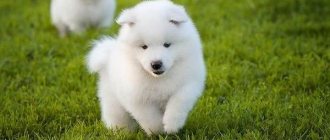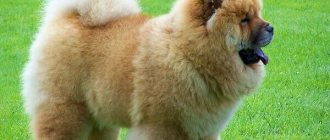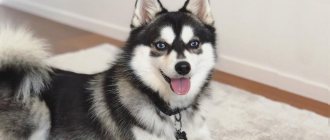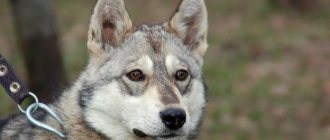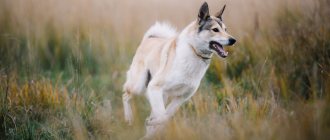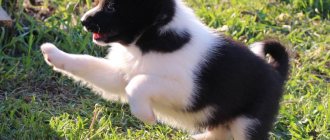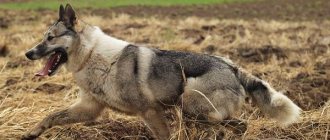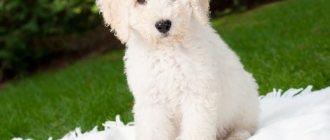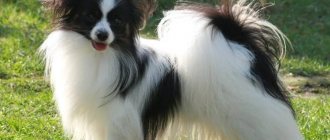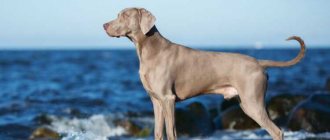It is impossible to pass by a snow-white smiling dog indifferently. Even a fleeting glance cast at this animal evokes a lot of positive emotions. Many people mistake this breed for a variety of huskies or spitz. In fact, the shaggy, happy dogs are called Samoyed dogs. For a long time, they were faithful companions and reliable partners of the ancient nomadic reindeer herders.
Description of the Samoyed Laika breed
Popularity 118th place among 263 dog breeds
Lifespan:
12-15 years
Breed group:
Service
Height:
50-55 cm
Country of origin:
Siberia and northern Russia
Average price:
20-30 thousand rubles
Weight:
15-30 kg
Latest articles Cat health
Rabies vaccination for cats: choice of vaccine, necessity, schedule 01/22/2022 4 0 0
Selection and adaptation
TOP 20 best cat breeds for families with children 01/22/2022 25 0 0
Advantages and disadvantages
- Pros:
- good-natured and sociable, including with children;
- gets along well in an apartment;
- has good health, is strong and resilient;
- does not require special care and nutrition.
- Minuses:
- has a hard time with loneliness or resentment, as a result of which things in the apartment suffer;
- sheds heavily and requires combing;
- tries to take the place of leader, which complicates training;
- is quite expensive.
Key facts
You have no chance of being ignored when you go for a walk with this dog: the large snow-white dog invariably attracts attention and causes admiration.
The Samoyed is a primitive or indigenous breed, meaning that no selective breeding methods were used to breed it. This becomes clear upon a quick reading of the main characteristics of the Samoyed breed.
Samoyed huskies live in a pack according to its laws. The Samoyed is a friendly, quick-witted animal, but not prone to obedience the first time. This is where the nature of the breed comes into play.
Don't put the Samoyed on a chain! Although this breed can handle cold winter nights well, it is a companion dog, not a guard dog, and therefore does not like to be alone. The description of the Samoyed breed emphasizes that a dog will not make a watchman.
Samoyeds have the character of a loyal companion, focused on living in human society. For many centuries they have served people in the extreme north and extreme cold. A dog living with a person in such conditions has a special character. In the Arctic, they are indispensable helpers for people - they hunt large animals with them, nurse children, and protect herds of deer.
But they were not particularly used in dog sleds, since the cultural traditions of the Nenets do not allow the use of these dogs as sled dogs. There are several photos of northerners with dog sleds, but they are harnessed to other dogs. At night, Samoyeds are often allowed into the tent and cuddle with them while they sleep.
Thanks to the purity of genes, the life expectancy of Samoyeds is very long. Under appropriate conditions, snow-white beauties live 14-15 years or more.
The Samoyed Laika is an unusual breed; none of its names reflect all of its characteristics. You can immediately recognize her by her fur, easy smile, curiosity and love for people. This dog delights those around him and his owners.
Choosing a nickname
The name for the puppy should not be complicated, easy to pronounce, consisting of 1-2 syllables.
- You can take a characteristic external sign or character trait as a basis.
- Kogan, Teza, Bike, Isa, Nord, Boni, etc. are suitable.
- Still, the undeniable advantage of Samoyeds is love at first sight for this snow-white beauty.
The shortcomings of the four-legged friend are perfectly compensated by his advantages: Friendliness, sensitivity, loyal character.
No one will remain indifferent when they see this elegant dog with a sea of charm.
History of the origin of the Samoyed dog
For about three thousand years, Samoyed dogs have been faithful companions of people. Their appearance has remained virtually unchanged since ancient times.
The first mentions of them can be found in the Samoyed language. Some of the Samoyeds - the ancestors of the Nenets - separated from the main people and moved from the Sayan Mountains in modern Khakassia to the Arctic Circle.
The Samoyed people also bore other names - “Samoyeds”, “Samoyeds”, “Samoyeds”. Their dogs got their name from the name of the nationality. The sammie is believed to be a domesticated polar white wolf. Northern working dogs are especially similar to their ancestor.
The ancestor of modern dogs is the Aboriginal Samoyed. We owe the existence of the breed in its current form to Londoner Ernst Kilburn Scott, who brought three dogs from a trip to the Arctic - a coffee baby with the simple name Dog, a cream-colored female White Pechora and a snowy male Masti. The modern Western Samoyed dates back to these and other dogs brought by researchers a little later.
In 1909, Scott created the Farmingham kennel, and a little later a club for admirers of northern dogs arose. Around the same time, the breed standard was determined, which has remained virtually unchanged since then.
E. C. Scott informally classified all Samoyeds into three types: wolf-shaped, bear-shaped and fox-shaped. This division continues today. Their difference lies in the structure of the head.
The standard has remained virtually unchanged since its inception, last modified in 1988 by the British Kennel Club.
For 20 years, the breed won the hearts of people, and by the 30s, nurseries appeared in different parts of Europe. Thanks to them, we know the Samoyed Laika, since in our time it is almost impossible to find an aboriginal Samoyed even in the Far North, although Nenets Laikas live there, among which there are many white dogs that look like the aborigines. The number of Samoyeds in the Russian Federation today is about 2,500 individuals.
Main types of colors
White is the canonical color for the Samoyed.
Few people know, but the standard includes two more colors. Let's look at each in a little more detail :
- White . Looking at a white Samoyed, one would like to call it snow-white - its fur reflects sunlight and sparkles beautifully. This effect is created thanks to the translucent tips of the guard hairs.
- Cream . The wool has a pleasant, warm tint. A dog with this color looks attractive, but has much less chance at an exhibition than a snow-white individual.
- White with biscuit spots . The rarest color. The predominant mass of the fur is snow-white, and only some areas are chaotically colored in a pale, biscuit shade.
Yellowing of the Samoyed's white coat may be a sign of improper grooming , illness, or an excess of animal proteins in the dog's diet.
Sometimes black Samoyeds are also found, but this coat color is not recognized by the breed standard.
Appearance of a Samoyed dog
General impression
The photo of the Samoyed shows that the dog is medium in size, harmonious in build, full of dignity. It is impossible not to notice it and not pay attention to it.
Head
The head is wedge-shaped, powerfully developed with a slightly convex forehead. The ears are set at a sufficient distance. The muzzle gradually tapers away from the skull and ends in a black nose. The rim of the nose always has black pigmentation, and the nose itself can become lighter in winter (the so-called “snow nose”).
The lips also have black pigmentation, and are turned up at the corners in a “Samoyed smile.” The dental formula is complete, the teeth are closed in a scissor bite. The eyes are almond-shaped, with an oriental slant and black edging, set at a wide distance. The ears are triangular in shape, slightly rounded at the ends, mobile, set wide apart; they shouldn't hang.
Neck
The neck is strong and proudly arched.
Torso
The body is almost square, slightly elongated in length. It begins with a powerful chest, continues with a strong back with a pronounced waist, and ends with a slightly sloping croup.
Forelegs
The forelimbs are straight and even, widely spaced, parallel when viewed from the front. The paw is slightly elongated, with elongated toes, between which hair grows to protect against the cold.
Hind limbs
The hind limbs are also straight and parallel, with clear articulation angles and a developed muscle corset.
Tail
The tail is set high, very fluffy and long. When running and when excited, the tail is carried over the back or to the side, but not curled into a donut. When at rest, it hangs relaxed, reaching to the hock joints.
Movements
All the power and tirelessness of the Samoyed is visible in movement. The hind legs push strongly, the front legs move with a powerful swing. The step itself is long.
Wool
The coat is fluffy, the coat is “double”: the top layer is made of long and hard guard hair, and the bottom “lining” is made of short, soft undercoat, similar to fluff. A particularly thick “collar” is formed around the shoulders and neck. In males it is more pronounced than in females. On the head and front legs the hair is shorter, on the ears it grows perpendicular to the surface of the ear, and there is also hair inside the ear.
Hind legs with good feathering, forming fluffy pants. Males have coarser hair than females. The Samoyed's fur sparkles and has miraculous abilities - it fluffs up in the cold, and the stronger the frost, the fluffier the dog. In addition, she knows how to clean herself. Wool is hypoallergenic and has no characteristic odor.
Color
Samoyed colors come in several variations: snow white, cream or basic white with a few biscuit spots. In no case should the color or markings appear beige or light brown.
Dimensions
Samoyeds vary in height by gender. Males are taller than females, their height is 54-60 cm, females - 50-54 cm. The weight of a Samoyed, depending on height and gender, ranges from 20 to 30 kg.
The size of the Samoyed allows it to be kept in an apartment - but only on condition of daily long walks with increased activity.
Thick long hair
The lush, dense coat is made up of a hard outer coat and a thick undercoat.
- A chic fur collar hides a medium-length curved neck and powerful shoulders.
- And beautiful “pants” adorn the dog’s strong hips and tail.
- On the limbs themselves and on the head, the hair is not so long.
- The hair on the ears is short on the outside and covered with fur on the inside.
Character of the Samoyed dog
The Samoyed is an ideal companion, calm, but not phlegmatic. Sammi's positive qualities are energy, trustfulness, and courage. Their busy mind must be constantly busy with work. One of the disadvantages of the Samoyed's character is stubbornness.
Living in difficult conditions and the need to coexist peacefully with people and other animals have made Samoyeds conflict-free dogs, so you don’t have to fear for the lives of cats, parrots and hamsters when you adopt a Samoyed husky puppy into your family. This same feature makes the Samoyed unsuitable for security and guard duty: the Samoyed will, at best, be wary of an intruder.
A cowardly or aggressive Samoyed is excluded from breeding. Although in the past people hunted shoulder to shoulder with these dogs, hunting is now not included in the list of functions of the Samoyed. But they are active and love to play. The best entertainment for Samoyeds is sled riding competitions, and children love it when dogs ride them in sleighs.
The Samoyed family is a pack for him, he builds a clear hierarchy in it. Samoyed huskies do not like to be alone, they are sociable and sociable, so this breed is unlikely to suit you if you are rarely at home. Although Samoyeds feel great outdoors in winter, it is absolutely forbidden to put him on a chain in the yard or keep him in an enclosure for a long time: it is better for the dog to live at home and closer to people.
The Samoyed is an ideal pet for a family with small children. Sammies love playing with babies. At the same time, the size of the dog is large enough, which eliminates the possibility that a child will harm the pet. A Samoyed puppy will become your little one's best friend, and an adult dog will become an attentive nanny.
Samoyeds rarely bark, but their owners often say that the dogs “talk.” They need physical exercise, so if you want to get a Samoyed, be prepared for an active pastime. If you are a homebody who prefers reading a book in the apartment instead of going for a run, consider a calmer breed.
Why is it called that?
As already mentioned, dogs of this breed got their name from the name of the tribes in which they lived since time immemorial. Therefore, “Samoyed” has nothing to do with the food habits of this dog, or with something more unpleasant and scary.
Currently, in the northern regions of our country there are practically no purebred individuals of this breed. And experts cannot attribute with 100% certainty those Samoyeds that currently live there to purebred Samoyed huskies. And those individuals that are currently found among many dog breeders in our country were imported from Western countries, where they began to be bred in the last century.
Education and training
Samoyeds are highly trained and trainable, but historically they have been forced to make their own decisions to preserve their lives, and this independence often interferes with training. They do not like monotonous exercises: you will have to strain your imagination if you want to keep the dog’s attention for a long time during training.
The first play-based training should begin as early as possible. By this point, you must already put yourself in the place of the leader in the puppy’s hierarchy, otherwise there will be great difficulties with education.
There are certain techniques for establishing leadership in your relationship with your puppy; By following them, you will easily rise in the dog's hierarchy.
- The leader eats first. Feed your dog after you have eaten lunch.
- The leader is the first to enter and exit all doors. If the puppy climbs forward, pull him back.
- The leader is sleeping upstairs. Do not allow a dominant dog to climb onto elevated surfaces such as sofas and beds.
- The initiative for the game comes from the leader. Don't give in to your dog's requests to play, wait a while and offer the game yourself.
- If you give your dog a command, always ensure that it is executed correctly.
- Impermanence is your worst enemy. If you allow something today and prohibit it tomorrow, the dog will not react to the ban.
- If the puppy becomes impudent and snaps, press him to the floor until he is completely submissive, or, if his weight allows, you can lift him by the scruff of the neck and shake him lightly.
These rules may seem harsh, but they are necessary for raising a large dog. If a dog considers itself a leader, this is a direct path to problems. Earning authority from an adult dog is much more difficult than from a puppy.
To successfully raise and train a Samoyed, you will need patience and self-control, but the results will delight you for many years.
Health and diseases of the Samoyed dog
Possible diseases
Samoyed huskies are a healthy breed. But there are a number of possible diseases for the breed - hereditary, infectious and accidental, and the future owner should be aware of them.
- Infectious diseases. Dogs from the north are susceptible to infections, and Samoyeds are one of them. Therefore, it is necessary to vaccinate on time. Puppies receive their first vaccinations from the breeder, that is, the veterinary passport should already contain marks. The breeder or veterinarian will tell you about the further vaccination regimen. The frequency of vaccinations may vary depending on the vaccine.
- Hereditary diseases. To avoid hereditary diseases, all matings are carefully calculated, but still sores sometimes creep out. These include hip dysplasia, which manifests itself after six months. The dog gets tired quickly, does not run and becomes less energetic. Timely treatment will not get rid of the disease completely, but will give your pet many years of vigor. Another hereditary disease is the scourge of all white dogs - deafness. In the case of a Samoyed, it is quite difficult to notice it. Usually the dog does not respond to the name, does not respond to voice commands. There is no cure for deafness. Hereditary diseases also include a variety of eye diseases - cataracts, glaucoma, retinal atrophy. Some of them are treated more successfully, some are not. Be reasonable, respect the work of breeders and do not breed dogs with hereditary diseases!
- All other diseases are classified as random diseases. The most common occurrence is bloating. To avoid it, you need to monitor your pet’s diet and not feed the dog before a walk.
Treat your dog against insects in a timely manner. When bitten by a tick, carefully monitor your dog, as ticks carry such a deadly disease as piroplasmosis. There are now vaccinations against this disease.
If you see that your pet’s behavior has changed, he turns his face up from food, goes to the toilet differently - it’s better to play it safe and go to the veterinary clinic.
Reproductive health
Bitches come into heat early, between six months and a year. In the future, it repeats with regularity every 6-7 months. Males also mature before the age of one year, but it is too early to breed dogs of both sexes.
The optimal time for breeding a bitch is 18 months, given that she has passed all examinations and is completely healthy. Males can be born from 15 months.
How to name?
When choosing a suitable nickname for a Samoyed husky puppy, you can focus on both its external features and character. Quite popular variants of names here include Sunny, Sammi (another name for Samoyeds), Whitey, Belka (Belek, Belyash), Snezhok (Snezhka, Snezhinka), Shuga (Sugar), Snowdy, Snow. Other common name options are Blanc (Bianca, Blanca), Alba (Albert, Albo), Salt, Zephyr, Pearl, Ice, Frozy, Cloud, Angie (Angel), Crystal (Christa).
A Samoyed Spitz boy can be called Cosmos, Star, Prime, Grand, Bright, Titan, Atlant, Boeing. Playful and mischievous puppies are often given the following nicknames: Tyson, Fayt, Game, Play, Fly, Casper, Charlie, Dexter, Joy, Brivi.
Nicknames that are consonant with the names of ancient deities and mythical characters are suitable for dogs of this breed. Examples here include the following options: Zeus, Hermes, Mars, Uranus, Hercules, Argo, Pegasus, Sphinx, Orpheus, Hephaestus, Theseus, Jason. For girls of the Samoyed breed, the following names from the proposed themes are suitable: Nymph, Venus, Athena, Hera, Vesta, Diana, Shakti, Ariadne, Medea, Calypso.
Very often Samoyed huskies are called by beautiful and euphonious foreign names. The most popular options here are the following nicknames for male puppies: Charlie (Charles), Archie (Archibald), Arthur, Oscar, Tyler, Gordon, Jamie, Jakey, Dexter, Ryan, Edward. The following names are often chosen for female puppies: Gerda, Greta, Margot, Bertha, Emma, Adele, Britney, Evie, Grace, Amelie, Alice, Rose, Darcy, Zena, Giselle, Chloe, Heidi, Aisha, Ivory, Yvette, Vega .
Nicknames associated with the world of secular fashion and the attributes of a glamorous life are also very popular among dog breeders. Examples here include such variant names as: Versace, Prada, Tiffany, Gucci, Dior, Cartier, Cardin, Chanel, Dolce, Chloe, Birkin, Rolex, Bentley. The following nicknames also sound original: Snoopy, Bambi, Shanti, Pretty, Darcy.
Features of feeding and diet
When selling a puppy, the breeder will tell you how to feed, what to feed and how many times to feed the Samoyed. Initially, it is better to follow the breeder’s recommendations, and then you can decide for yourself what food to feed the dog. If you want to switch your dog to a different type of food, do not do it suddenly. You need to add a few granules of new food to the old food and gradually increase the amount. The transition takes 10-14 days.
If you choose dry food as food, purchase high-quality premium food or holistic food with a high protein content.
You can give your Samoyed fish and cottage cheese daily. It is better to give the natural part of the diet in the morning feeding.
If the food is balanced, then additional vitamin complexes are not required.
What's best to feed?
Most veterinarians recommend feeding the Samoyed dry food, as it contains the right amount of nutrients.
But natural nutrition is also acceptable. First of all, it should be said that the Samoyed must be given raw meat. This is the basis of the diet. The second important point is milk; it should be completely excluded from the diet, as it causes diarrhea in the dog.
IMPORTANT!
Do not teach your dog to feed from your hands or from the floor. She must have her own bowl and a certain time for feeding.
Diet of an adult Samoyed:
- 30% – meat (raw or cooked),
- 30% - fermented milk products (yogurt, kefir, cottage cheese),
- 20% - boiled sea fish (dogs love it very much),
- 20% - cereals, vegetables, offal (beef tripe, heart, liver).
Prohibited products:
- Chocolate.
- Eggs.
- Smoked meats.
- Potatoes and beans.
- Pork.
- Baking.
You need to feed your pet strictly 2 times a day.
You can use cheese, sugar seeds or rye crackers as a treat.
It is better to feed your pet after a walk. This promotes better absorption of food and also prevents excess weight.
Care and maintenance
The luxurious white coat of a Samoyed can bring a lot of unpleasant moments if you care for it rarely and irregularly. A dog's love for brushing will make life much easier. Teach your puppy to brush himself about once a week from early childhood and accompany the process with positive reinforcement so that the puppy associates it with pleasure. A Samoyed does not require a haircut, but sometimes show dogs undergo grooming to highlight their strengths and hide body flaws.
If you are not going to show your dog, washing it a couple of times a year is enough. Exhibition specimens are washed with special shampoos before each exhibition. You can wash off dirt from your paws and belly after each walk. On particularly dirty autumn and spring days, wear a waterproof mudguard on your Samoyed to keep his coat clean.
An indispensable assistant in the care and maintenance of a Samoyed will be a compressor and a grooming table. The compressor dries the fur several times faster than a hair dryer, without drying out the skin and fur of the animal. Your back will thank you for the grooming table; Plus, it has been noticed that dogs behave more quietly on the table.
During shedding, you need to brush your long-haired Samoyed more often than usual. You can blow dry hair with a compressor - a stream of air blows out fallen hairs and dead skin particles, massages the skin, improving blood circulation.
The dog's coat perfectly regulates temperature not only in the cold, but also in the heat. Therefore, if you shave or trim your pet's thick coat, he is more likely to suffer from overheating than from being covered in fur.
Teeth are brushed once a week, ears are sometimes wiped with a dry cloth. Samoyeds' claws usually wear down on their own if you walk them enough.
Walks should be quite long, at least an hour and at least twice a day. It is better to spend this time actively and variedly - running, playing, doing a little training. A well-walked Samoyed will calmly take its place on the bedding and will not cause damage to the house.
Tips for choosing a puppy
Answer yourself the question, why do you want a Samoyed?
- For home, for family, for the soul, that is, a friend and companion. In this case, you can just take a healthy puppy you like.
- Samoyed for exhibitions and shows. If you are a beginner, it is better to consult with someone who understands the breed. The pedigree must be of the RKF-FCI system; it is good if the puppy has ancestors with a championship background. Often the breeder assumes the chances of the puppies, and the most promising one can be sold only on a co-ownership basis. You may still have to convince the breeder that you are worthy of buying the best puppy in the litter, and prove your readiness to pursue a dog's show career. The price of such a puppy is high.
- Working dog for participation in sledding competitions. Such a puppy must have working parents.
In addition to a set of documents, Samoyed puppies have a brand, and with the breeder you will sign a contract for the purchase and sale of the dog, and possibly a co-ownership agreement.
Head
The different head shapes divide the breed into 3 types: fox, wolf and bear.
Fox type
- Small head;
- The muzzle is pointed;
- Ears are sharp.
Wolf type
- The head is round;
- The ears are rounded;
- The nose is extended.
Bearish type
- The head and ears are wolf-type;
- But the muzzle is short.
The almond-shaped eyes are deep and wide-set, slanted and slightly cunning. Definitely black. Another prerequisite for the purity of the breed are black lips and nose.
How much does a Samoyed dog cost?
The price of a Samoyed with documents starts from 15 thousand rubles and can reach up to hundreds depending on the blood and class of the puppy. The seller reserves show and working puppies from trusted producers who produce high-quality offspring at the stage of pregnancy of the bitch, and sometimes even before mating.
The cost of mating is approximately equal to the cost of a puppy, and if the mating involves traveling to foreign nurseries, it is even more expensive if you count travel expenses.
The high cost of a show dog is a guarantee of your solvency and the ability to pursue a dog’s career, since exhibitions and preparation for them are also expensive and take time.
You should not buy a dog “for the child”, “as a gift for the child” or because “the child really asks”; be prepared that caring for the dog will fall on you. And if you treat your dog with love, it will repay you a hundredfold.
Do you like the article? 0
Price
The price of puppies with a pedigree depends on which class it belongs to:
- pet - class - dogs of this class can be beloved pets, but do not participate in exhibitions and are not suitable for breeding. Their cost is 10,000-20,000 rubles;
- breed class - dogs of this class are suitable for breeding, their cost is 250,000-35,000 rubles;
- show class - Samoyeds of this class are 100% purebred, their pedigree includes only titled ancestors, such dogs are regularly taken to the most prestigious exhibitions, where they are able to receive first places. Their cost is 35,000-65,000 rubles.
And it should be remembered that these active, intelligent and friendly dogs are perfect for equally active owners who love dogs and are ready to spend almost all the time next to them.
